Wheelchair Cushions

Without the proper padding and support, pressure sores are likely to develop or worsen, and chronic pain can develop as a result of poor posture and constant pressure on joints. To prevent all these issues, selecting the right cushion is essential.
Wheelchair cushions typically provide:
• Comfort
• Postural support- assists the user to sit more upright, and where possible in a neutral position
• Pressure relief
Considerations when choosing a cushion:
• Comfort
• Stability
• Skin Protection: Cushions that offer pressure relief and reduce friction can help prevent pressure sores from developing.
• Microclimate: The temperature and moisture of the patient’s body against the seat affect skin breakdown. A cool seat with good airflow is optimal.
• Cushion Weight: Heavier cushions offer more comfort but add weight that could affect self-propulsion in a lightweight wheelchair. For someone who has spent a lot of money to purchase an ultra-lightweight wheelchair, consider avoiding a heavy gel cushion. Also, if the user will be lifting the cushion on and off the chair regularly (e.g. for transporting in the car), the weight of the cushion needs be considered.
• Cushion Height: A higher cushion could make it easier to reach counter surfaces, but it might mean the patient’s wheelchair doesn’t fit under a table or desk. It is important to make sure that the height of the cushion allows for easy transfers for the patient.
• Maintenance & Durability: Some cushions require regular maintenance and monitoring to check they are working optimally (e.g. ROHO), whereas others are low maintenance like honeycomb cushions.
• Incontinence: Need a waterproof, easy to clean cover.
• Price: Does the cushion fit the patient budget? Think about how long each type cushion lasts on average and the features it offers, to make an informed decision.
Cushions can be described in different ways, including:
• The material they are made from e.g. Foam
• The material they are filled with e.g. Air, fluid or gel
• Their main function e.g. Pressure relief, comfort, posture support
• Their shape e.g. Flat or contoured
• How they are made e.g. Foam cushions may be “molded” from one piece of foam or “layered” made from a number of layers of foam.
| Type of Cushion | Advantages | Disadvantages | Picture | |
| Foam | The most basic of all the types of wheelchair cushions. For patients with minimal to moderate positioning needs. | • Affordable • Lightweight • Versatile • Low maintenance • Density – defined as mass of foam per unit volume and varies from low to high. Higher density allows more thickness and depth and so gives more support. It also retains its support properties for a longer period of time • Firmness – soft to hard. These may be used in combination where closer to the sitting surface, the foam is soft to enhance comfort and body conformation whilst the base is harder to maintain shape and integrity of the cushion • Can be cut to various shapes and sizes according to individual requirements |
• Limited pressure relief • Limited comfort • Limited stability • Foam compresses, becoming flatter and firmer over time. For this reason, foam cushions should be checked regularly and replaced every 1 – 2 years. • Foam insulates and can cause an increase in tissue temperature. |
|
| Gel | Designed to provide protection and comfort with blended gels in pouches. Offers optimal pressure relief to help protect delicate skin, and to help prevent pressure ulcer formation for long-term wheelchair users.
Typically attached to a foam base. The more foam layers added to the cushion, the stiffer the cushion and the firmer the support. |
• Conforms to the shape and bony prominences of the user’s body, and moves with the body. This protects the delicate skin and prevents pressure sores • Sturdy enough to be used throughout the day • Provides a stable surface • Provides comfort and support • Adequate positioning – Improves posture, supports good body mechanics, and prevents further deterioration of bones and muscles • Low maintenance • Provides cooling |
• Susceptible to ruptures and leaks • Gel pockets may need to be kneaded occasionally to redistribute the liquid • The gel pocket adds weight to the cushion so if there are weight restrictions or mobility issues this might not be the right cushion |
|
| Air | There are varying numbers of cells or sacks that hold air at a desired amount determined by the weight and requirements of the user. The air can be adjusted with a pump in addition to removing or adding the cells themselves for custom comfort. The air acts by distributing the weight of the pressure points evenly, which will help prevent circulatory issues in some users
Focus on the ROHO cushion: |
• Adjustable air cells. The adjustable cells make this cushion an excellent option for individuals who have had past issues with pressure related sores and ulcers • Excellent weight distribution • Lightweight • Washable |
• Requires manual pumping of air • Not recommended for advanced positioning and stability • Offers less stability than gel, foam, or hybrid cushions |
|
| Honeycomb | The design of a honeycomb wheelchair cushion mimics the natural formation of a honeycomb. The design lends itself to being very stable and able to withstand extended periods of pressure.
|
• Provides adequate support • Easy to customize the shape • Stays cooler than other cushions due to air circulation • Extremely durable and comfortable |
• Not recommended if positioning or weight distribution are a major concern | 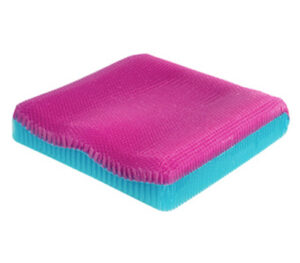 |
| Hybrid | A hybrid wheelchair seat cushion is one of the most advanced and high performing cushions on the market today. It offers the best of all the options that are out there in one package. It provides equal pressure distribution, allowing increased blood flow while providing skin and soft tissue protection. The contoured foam base, air cells and moisture control cover are just a few of the features of the hybrid wheelchair cushion. | • Air-cell system protects skin and reduces pressure by offering exceptional pressure redistribution to effectively treat and prevent pressure wounds and ulcers • Ideal for individuals with impaired sensation • Very stable, allows for stable transfers • Enhances positioning and facilitates transfers • Ideal for pelvic correction • Suitable for weight up to 500 lbs |
• Can be costly |
|
| Alternating Pressure | An alternating air pressure cushion system is the best wheelchair cushion for preventing pressure sores and ulcers and may be the only option that works for individuals who are unable to move and carry out pressure relieving movements during the day. The dynamic wheelchair cushion provides constant movement that promotes circulation while providing comfort and support. It consists of several inflatable bladders similar to a basic air cushion with the addition of a microprocessor that controls inflating and deflating of air every 4 minutes throughout the day. A portable battery unit supplies power to the cushion that can last in excess of a hundred hours before needing a recharge that allows for continuous varying pressure points. | • Extremely comfortable • Long battery life • Easy to operate • Durable |
• Costly • Battery needs recharging |
|
.
|
MATERIAL |
||
| Material | Benefits | Downside |
| Foam | • Low cost • Lightweight • Low maintenance |
Can “bottom out” quickly (lose its shape) |
| Gel | • Good pressure distribution • Keeps you cool and can be used with a foam base |
• Heavier, adds weight to the wheelchair
• Knead prior to each use to keep gel in place |
| Air | • Exceptional pressure relief • Adjustable firmness |
• Air levels need to be checked daily for leaks
• Less stable |
| Honeycomb | • Stable • Keeps you cool |
• Limited pressure distribution and positioning |
| Alternating Pressure | • Automatic pressure distribution to prevent pressure sores • Ideal for those who can’t adjust their position |
• Higher cost
• Battery needs to be recharged |
|
POSITIONING/ SUPPORT |
||
| Recommended for: | ||
| Contoured |
|
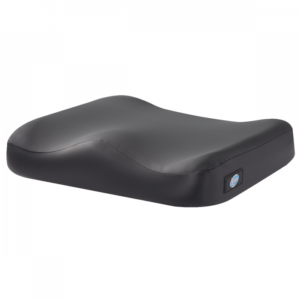 |
| Anti-Thrust |
|
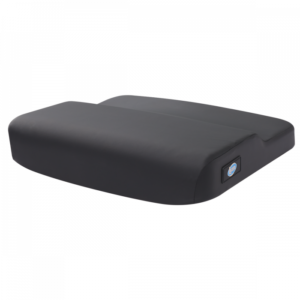 |
| Wedge |
|
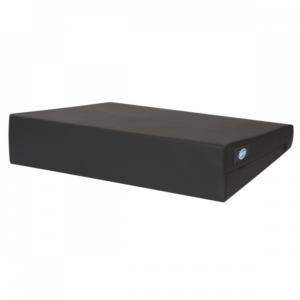 |
| Pommel |
|
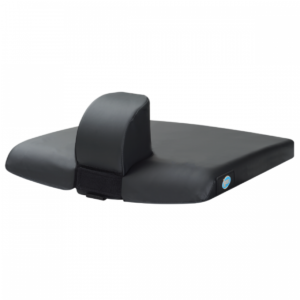 |
| Sacral Cut Out |
|
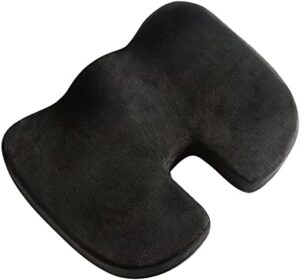 |
| No Lean |
|
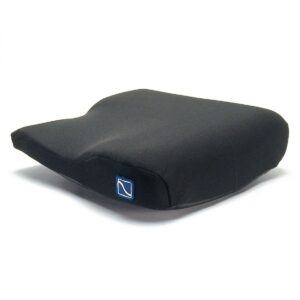 |
| Amputee |
|
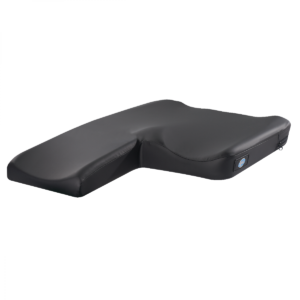 |
Examples of cushions for pressure ulcer prevention/treatment
Super Soft Econo-Gel Cushion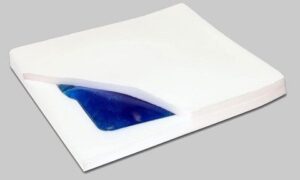
Combines the pressure relief of gel with the stabilizing aspect of high-density foam.
ROHO Contour Select Wheelchair Cushion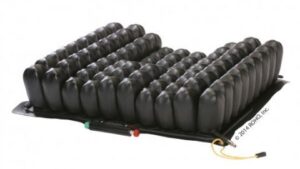
Air-filled, conforms to the user’s unique seated shape in order to provide customized immersion and corrective positioning support. Ideal for those who are at a moderate to high risk of developing pressure sores, this wheelchair cushion uses Isoflo Memory Control Technology that inflates and distributes air to each of the cushion’s 4 quadrants, depending on the desired positioning. A contoured design keeps the pelvis centered and positioned in a an upright, aligned position while also minimizing swaying with stabilizing support.
Sunrise Medical Jay Union Wheelchair Cushion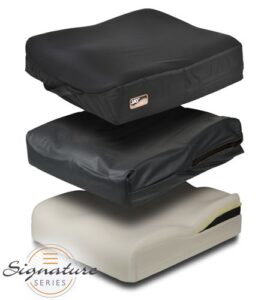
Features dual layers of Visco™ memory foam over a stable foam base with an integrated fluid pad, making the cushion comfortable and supportive. The memory foam shapes itself to best fit the contours of the user, while the fluid pad redistributes and relieves pressure. Lateral wedges and a pelvic loading area improve lateral, anterior, and posterior pelvic stability.
Saddle Zero Elevation, Wedge, and Anti-Thrust Wheelchair Cushion by Comfort Company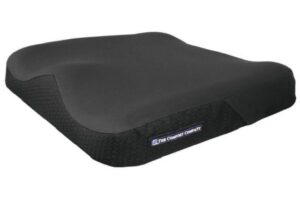
Provides comfortable seating support that helps prevent and heal pressure ulcers. A coccyx cutout takes pressure off the tailbone, while deep lateral and medial leg contours promote an upright body position. To take pressure off the legs, a waterfall front is included in the Saddle Wheelchair Cushion design.
Resources:
https://www.physio-pedia.com/Cushions
https://www.wheelchair-works.com/wheelchair-seat-cushion.html
https://www.performancehealth.com/articles/your-ultimate-guide-on-how-to-choose-a-wheelchair-cushion